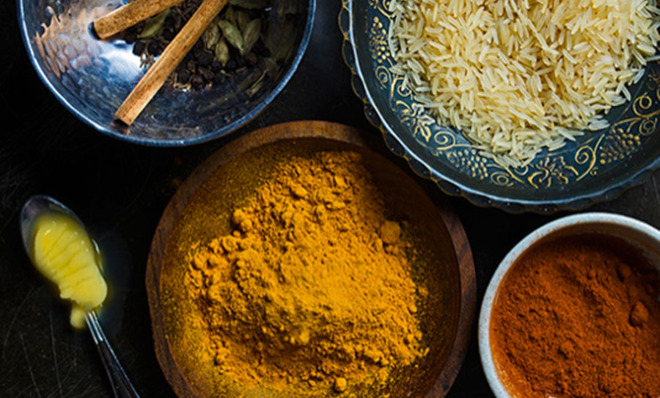Everything you need to master Indian cooking at home
Embrace the ghee


Diwali is here, and the best way to celebrate the Indian Festival of Lights is with an epic meal. Before you start cooking up a kaleidoscopic spread of curries, biryanis and masalas, here's what you need to stock your kitchen with.
① Basmati Rice
Rice is the biggest staple of any South Asian meal, and the go-to variety is basmati. The thin long grain, which originates in India, has a uniquely nutty aroma. The rice can be prepared plain or dressed up with meats and vegetables, like in biryanis and pulaos.
The Week
Escape your echo chamber. Get the facts behind the news, plus analysis from multiple perspectives.

Sign up for The Week's Free Newsletters
From our morning news briefing to a weekly Good News Newsletter, get the best of The Week delivered directly to your inbox.
From our morning news briefing to a weekly Good News Newsletter, get the best of The Week delivered directly to your inbox.
(More from Tasting Table: Pumpkin and pecan pancakes)
② Ghee
Ghee is clarified butter simmered for a step longer, which separates the milk-fat solids from the liquid, resulting in a rich, nutty product that's thicker than normal butter. It's used in addition to or as a replacement for cooking oils.
③ Masoor and chana dals
A free daily email with the biggest news stories of the day – and the best features from TheWeek.com
Split dried legumes, also known as dal, are another one of those essential ingredients for Indian dishes, like stewed dal. Masoor dal comes from red lentils, and chana dal from the halved kernels of black chickpeas.
④ Atta flour
The ground whole-wheat base of atta flour makes for doughs that are easier to stretch thin, a necessary step when making flatbreads like rotis, naans, and chapatis.
(More from Tasting Table: Hat Yai fried chicken)
⑤ Red chile powder
Spiciness is key to many Indian dishes, and that's where red chile powder comes in. Spice levels vary depending on what you can handle.
⑥ Turmeric powder
Like red chile, turmeric is another one of those ubiquitous Indian spices. Just a dash of the extremely piquant yellow powder (made from a plant in the ginger family) is enough to add color and flavor to biryanis, samosas, chutneys and more.
⑦ Garam masala
For a grab-bag of essential Indian flavors, use garam masala, a blend of several frequently used spices, for a warm, spicy zest that isn't overwhelming. Typically, it contains a mixture of peppercorns, cumin seeds, green and black cardamom seeds, cloves, and cinnamon sticks.
⑧ Tava
The flat, circular cast-iron pan known as a tava or tawa makes it easier to fry those breads you make with your atta flour.
(More from Tasting Table: The 12-bottle fall bar)
⑨ Sil-Batta
Don't bother with a food processor when you can literally put the stone to the grind with the sil-batta. Similar to a mortar and pestle, the sil-batta consists of a rectangular grinding stone with a rough surface on which to grind, and a solid barrel-shaped stone for pulverizing. Perfect for grinding spices, seeds, chutneys and masalas.
⑩ Madhur Jaffrey Indian Cooking, by Madhur Jaffrey
Of the many books in Madhur Jaffrey's Indian cooking repertoire, this one is the best go-to guide, with an easy run-through on the basics of the cuisine.
Tasting Table is a culinary lifestyle brand that obsesses over what to eat and drink so you don't have to. It's like having a foodie best friend to distill the culinary world into must-do, must-eat, and must-know recommendations, on everything from the best Thai in the Village to the top tequila pours in Outer Mission. Hungry yet?
-
 Political cartoons for December 17
Political cartoons for December 17Cartoons Wednesday's political cartoons include healthcare affordability hoax, giving up, and more
-
 Trump vs. BBC: what’s at stake?
Trump vs. BBC: what’s at stake?The Explainer The US president has filed a $10 billion lawsuit over the editing of Panorama documentary, with the broadcaster vowing to defend itself
-
 Animal Farm: has Andy Serkis made a pig’s ear of Orwell?
Animal Farm: has Andy Serkis made a pig’s ear of Orwell?Talking Point Animated adaptation of classic dystopian novella is light on political allegory and heavy on lowbrow gags